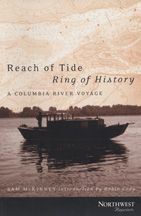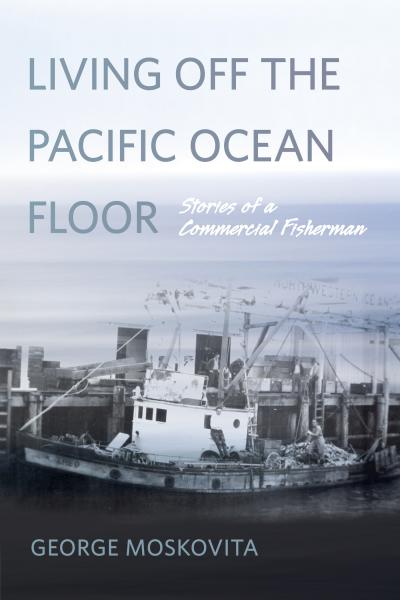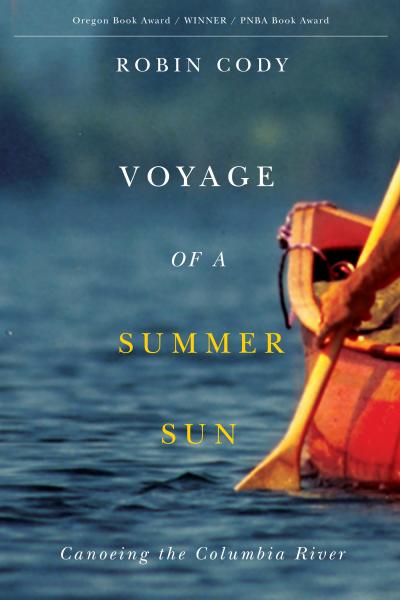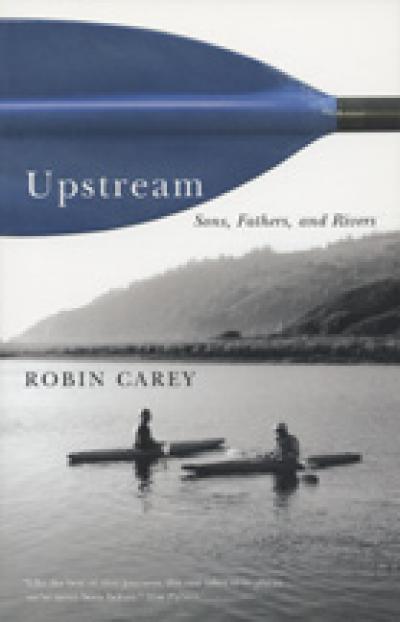
Reach of Tide, Ring of History
Sam McKinney
With a new introduction by Robin Cody.
Aboard a small handmade boat, Sam McKinney set out to rediscover the Columbia River of his youth. The story of his voyage offers an intimate history of the great river and of the people who have lived and worked along its shores.
McKinney, a seasoned explorer, historian, and riverman, begins his voyage on the sea. Following the path of Robert Gray's ship Columbia Rediviva across the treacherous Columbia River bar, he embarks on an upriver journey that leads beyond urban Portland to the barrier of Bonneville Dam. Along the way, he visits the sites of old Indian villages, the camps of the Lewis and Clark expedition, the rotting piers of early river communities, and the islands of the lower river.
Walking out along the jetty at the mouth of the Columbia, McKinney recounts how this infamous bar was formed, and how it was tamed by turn-of-the-century marine engineering. He sloshes through Astoria's rainy streets, recalling its origins as the first American outpost on the Pacific Slope and its lusty past as a working waterfront. His voyage takes him to ghost towns and abandoned villages — Chinookville, Frankfort, Knappton. He describes the development of the river's fishing industry and the harsh conditions faced by fishers during the industry's peak years. He remembers his own boyhood, working on the river as a gillnet fisherman and as a deckhand aboard one of the last sternwheelers.
Combining the river's storied history, rich personal memories, and observations gleaned from the deck of the 16-foot Gander, McKinney gives us a sensitive portrait of the Columbia river, a book that reflects the rhythms of tides that the author knows so well. "Two weeks on the river and I was only fifty miles upstream," writes McKinney, grounded on a hidden sandbar. "My wake, had it been recorded, would have revealed a slow, wandering track of curiosity — islands explored, old townsites discoverd, and unnamed channels followed."
About the author
Sam McKinney is a founder of the Lewis and Clark Columbia River Water Trail and the author of Bligh: A True Account of the Mutiny Aboard HMS Bounty. In the late 1980's he completed a 4-year, 5000-mile journey across North America through the inland waterways of the continent. He lives in Vancouver, British Columbia, and is a research associate at the Vancouver maritime Museum.
Read more about this author
Introduction to the new edition by Robin Cody
Preface
Bearings
The Bar of the Columbia River
Pilots Across the Bar
Search, Rescue, and Save
Fort Clatsop
Astoria
Forgotten Shores
Islands of the River
Fishermen of the River
Village of My Twelfth Summer
Gull Island
Visions and Settlements
The Last Steamboat
To the Reach of Tide
Bibliography
Index
Sam McKinney is the contemporary explorer and thinker who shares with us his intimate knowledge of, and love for, the Columbia River and its people. With Reach of Tide, Ring of History he takes us in his homemade wooden boat across the treacherous sand spits where the Columbia meets the Pacific, and back up the river's throat as far as the push of tide can be felt, beyond urban Portland. He gives us a riverman's look at where the first Columbians put their native villages, and why. He recalls how Euro-Americans discovered and colonized and began extracting a living from these places, and along the way we meet some intriguing characters still working at shoreline.
I'll call him Sam, here, rather than McKinney, for the same reason you wouldn't refer to Huckleberry Finn as Finn. Sam's forte is poling around by boat. We are in the company here of a literary river rate with a keen intellect, unfettered by academic degrees. Sam earned his credentials as a maritime historian the old-fashioned way, first-hand, by wet and cold voyages in which he retraced the routes of early explorers. Twice he has duplicated — journals in hand — Captain George Vancouver's exploration of Puget Sound, the Straits of Georgia, and Queen Charlotte Strait. And here on the lower Columbia he follows in the wake of Lewis and Clark. Sam probes a watery shore until its history is something he can feel, like mud between his toes.
It's true Same has dropped anchor briefly near the shores of academia. He directed the outdoors program at Portland State University. For the Oregon Historical Society, he coordinated the Columbia River heritage Program. He is the author of the scholarly Bligh: A True Account of the Mutiny Aboard HMS Bounty. And he looks like a scholar. Catch him off the river and you'd call him Professor McKinney, tweedy with elbow patches, lifting huge ideas between puffs on his pipe. But note that boyish shock of hair, as if blown across his brow by a stiff Nor'wester, even indoors. The river has etched crow's-feet about his eyes, laser-brown eyes that fix on a visitor as if sizing him up for partnership in, say, truancy.
Let's get out of here, he seems to be saying. Let's get out on the boat.
The boat trip that grew into Reach of Tide, Ring of History took place in 1985, when Sam was fifty-seven. In fact that trip was to have been the start of a 5,200-mile voyage that would have taken him all the way across North America, as much as possible by boat, from the Pacific to the Atlantic. Lucky for us, the river kept him home. Later — four years and two boats later — Sam did complete his cross-continental odyssey. But this book is about home. It's about this watershed, and how people have come to live here.
Sam's thirst for understanding drives him to seek the very same view that Robert Gray had when that Boston trader crossed the bar in Columbia Rediviva in May of 1792. Referring to journals, he positions himself at the precise angle from which Gray first probed the river's mouth. And so there is Sam, at the book's opening, his boat bobbing up and down with the sea gulls on ocean swells. We learn how the river from here is invisible, and why it was late to be discovered.
In his self-effacing narrative, Sam doesn't dwell on what na astonishingly daring or foolish act it is to be afloat at that spot in a sixteen-foot boat, powered only by an eight-horse Honda outboard. The focus is on the river and its history, not on him.
Nor did it occur to him to explain — other hat "I was in a small boat I had built..." — That he had conceived and designed this boat as well as built it himself. In fact Sam took his design inspiration from the writings of a British naval architect who pondered, How big does a boat have to be? and answered, Big enough to lie down in. Any bigger, Sam points out, and the boat invites two kinds of trouble: Expense and guests. Being a man of large self-sufficiency, and cheap, Sam laid himself out on two slabs of quarter-inch plywood, waved his arms for width, and drew pencil marks on the wood to include places to stand, front and back. He spent a grand total of $650.35 building this boat and called it the Gander. And it's a beauty. The Gander itself is barely mentioned in the book, Sam being also a man who assumes that anyone, any idiot, could make from scratch a boat that rides so prettily, almost sassily, on big water.
The book, like the boat, is of clean design and startling efficiency. Spare sentences and matter-of-fact observations belie the fact that Sam is navigating the largest of Northwest themes, the human-in-nature theme. After crossing the bar he gives us enough geology and hydrology to grasp what the bar is: a clashing of titanic natural forces, a river draining the west slope of the continent and meeting the inexorable push of the Pacific Ocean. Then we go straight to an account of the jetty-builders and dredgers who tamed the bar for ship traffic and made Portland a crossroads of commerce. He shags a ride with bar pilots to get their point of view, and he wheedles a Coast Guard search-and-rescue crew for theirs. Quickly a reader comes to understand why, since Robert Gray's crossing, the Columbia River bar — "The Graveyard of Ships" — has claimed over two thousand vessels and at least fifteen hundred lives.
Once we get into the river with him, Sam refers to the journals of Lewis and Clark as a benchmark for comparing the riverscape they experienced to the shoreline he sees. Like Captain William Clark, Sam is a sharp-eyed observer and scrupulous recorder of wild and human life. As if reporting to a faraway Thomas Jefferson, he is a one-man Corps of Discovery, nearly two hundred years after the original.
By boat he approaches the replica of Fort Clatsop, where the Corps of Discovery spent that soggy winter of 1805-1806, desperate to erect shelter and to find food and clothing. Excerpts from the journals punctuate Sam's trip across the river to Point Elice, as well, where the earlier explorers got pinned down for six days by November storms between inhospitable shore and raging river. We can almost feel Sam's shame at his too-easy modern life when he anchors the Gander on a calm June evening and from the comfort of his cabin — sipping sherry, noshing cheese and bread — contemplates the differences between then and now.
As he probes the waterfront of Astoria, Sam recalls how American settlement began in the Northwest. Astoria was to have been the center of an empire. Here at the gateway to vast natural wealth. Astoria was the very manifestation of the frontier ethic. Nature would provide; people would harvest. Astoria at the turn of the last century was a brawling ethnic collection of loggers and sawyers, fishers and cannery workers, their lusty appetites slaked by fifty-four saloons and thirty-five brothels. But economic hopes surged and plunged with the yo-yoing prices for fish and lumber. Faraway corporation set the market, whole the resource base declined. Astorians remain tough and stubborn, independent and proud, but flawed — as Sam sees it — by the fact that they could never quite shape their own destiny. Then as now, Astoria is not the hub of empire but an outpost. "Decisions made elsewhere set Astorians working overtime, hal-time, or no time at all."
On up the river Sam drops in on the villages and village sites once occupied by the first Columbians and more recently by Swedes and Norwegians and Finns. There is a sense of wonder at how recently the air sang with the sound of axes and mill saws, or at the clank-and-whiff from salmon canneries, and how rapidly it all went away. As if he didn't know why, Sam seeks out village elders for their local explanations of boom and bust. We come to understand the evolution of fishing methods, for example, from horse-drawn seines to the sail-powered "butterfly fleet" to the advent of gas-engine fishing boats and mechanized canneries. The internal combustion engine, in particular, not only gave greater range and safety to the fishing boats but also gave rise to highways and a pace of life that by-passed many water-facing communities. At Altoona, Svensen, and Clifton, Sam visits living museums of boat-building and fishing. Frankfort, Knappton, and Brookfield are no longer places, just dots on old maps and charts, where Sam pauses to eye the rotting pilings, or sagging wharf, of an abandoned way of life.
In "Village of My Twelfth Summer," arguably his best chapter, Sam recalls the time he and a fiend arrived by tiny steamer at the Grays Bay fishing hamlet of Frankfort. Two boys, alone, came to the friend's grandmother's house on their first summer away from home. Grandma's rules were few and clear. Stay out of the kitchen. Keep the wood box full. The boys slept in the hay loft, and by day were free to go Hucking around at water and woods.
Like Indians, we gathered wild berries from bushes, apples from the trees, and licorice root from the moss of the forest. With old fishboxes, we build rafts and floated the river, ran naked along the beaches, and swam in the small creek behind the house. The grandmother, busy about the house with canning, cleaning and sewing, left us alone. We were expected to be nothing but boys, by her definition half savage, dirty, and always hungry.
When the salmon runs began, the boys came under the tutelage of an old Finn who instructed them in the arts of gillnetting and swearing. Out on the river at night, they set the nets and alternated drifting and sleeping and working to the light of moon and stars, or maybe only to the tiny twinkling light on the float at the end of their net. We get Sam knee-deep in fish in the boat, and delivering their catch to Astoria. The boys wait for Fred, the old Finn, to stagger back from an Astor Street saloon. And then Same guides the boat back across the river to Frankfort. It's an "Aha!" kind of chapter, Sam revealing how the river got him at an early age:
In that memory I see a time of bright silence and a small fishing boat crossing the path of a setting sun. An old man stands at the keel, and next to him, two boys sit at the stern with bare feet hanging over the side, swinging to the easy motion of the boat's passage through the waves.
Later in the book Sam recalls his initiation as a fifteen-year-old deck hand on the sternwheeler George Burton. Due to a wartime shortages of workers, Sam was hired to work the winches that tightened the cables as the stern wheeler towed log booms up and down the Columbia. Worse than his fear of death from spinning drums and whipping cables was the verbal abuse he absorbed from the Burton's crusty old captain, who drove Sam teary-eyed to humiliation. With time, the captain began sharing with Same some of the hidden secrets and unwritten knowledge of piloting. Finally he gave Sam the Burton's leaky old skiff to command. And so it was here, while still a youngster, that Sam came to understand the river as an invigoration, sometimes terrifying, always soul-shaking force.
As Sam shuffles rich personal memories into his account of the river today, a reader comes to realize how dramatically and recently life on the river has changed. History has moved much more swiftly here than at other American places. Only in the last one hundred and fifty years or so did the people get organized enough to apply their axes and fishing nets to the taming of a harsh and adversarial nature. And here we have, in Sam, a man whose first-hand experience overlaps the paddlewheel era. He can not only recall the frenzy and excitement of those river-taming and woods-busting days of his youth; he can also take us back to visit these places at his own wise and literate slow pace.
Because the Gander draws less than six inches of water, Sam has access to places few motorized vessels can probe. He takes us among the tidal rushes and low islands, into the unnamed channels and muddy capillaries, of what is now the Lewis and Clark National Wildlife Preserve. The river is taking itself back. He notes a feast of life among creatures who are going about their business as if people had never been here. He threads his way among backwater sloughs, reading the silent water like a man who knows his way to the bathroom in the dark. Yet Sam takes particular delight in the times he is wrong, when a shallow passageway becomes a temporary dead end. The tide drops out from under him. The Gander gets wedged in mud, and he can only wait and think.
Temperamentally at odds with civilizing restrictions and rapid pace, Sam is at his best on islands. An island is a place for those small unexpected adventures that he calls the best part of any journey. An island, he notes, is a place for outlaws, misfits, and escapists. An island is far from the Widow Douglases of this world. Gull Island, in particular, is small enough for Sam to walk around but large enough to hold secrets.
All it needs is a driftwood shack. The river makes him twelve again. he scavenges driftwood and planks, boards and boxes, and settles in.
By evening I had what I thought was a unique shelter, and I moved in for the night.. The glassless window propped up in the sand framed the river and an evening sunset. Without a ceiling, I had over me a canopy of stars, a soft night breeze and the first light of a fiery dawn. In the morning, I disassembled the Shack and carried its parts back down to the beach for the river to float away and left Gull Island.
With Reach of Tide, Ring of History, Sam McKinney has written a big short book about what a river is. Through the eyes of an accomplished riverman and reliable historian, we see how life on the river has changed since Lewis and Clark. And how it hasn't changed. Sam's Columbia River is still alive with possibilities. We are in the company here of a modern explorer, a man with a large capacity for wonder. Sam writes it clean, and he gives rise to wonder in us, as well, not just at how people shaped the river but also how the river shapes its people.
<a href="/author/robin-cody">Robin Cody</a> is the Portland author of Ricochet River, a novel, and Voyage of a Summer Sun: Canoeing the Columbia River.




